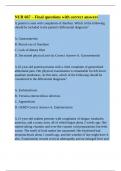Summary
Samenvatting - Teamwork - Theories, Design and Dynamics
- Course
- Institution
Dit is een samenvatting van het vak Teamwork - Theories, Design and Dynamics waarin de hoorcolleges, eventuele artikelen en de uitgebreide samenvatting van het vak wordt samengevat. Hierdoor staat alle nuttige informatie in 1 document en blijft het overzichtelijk.
[Show more]












